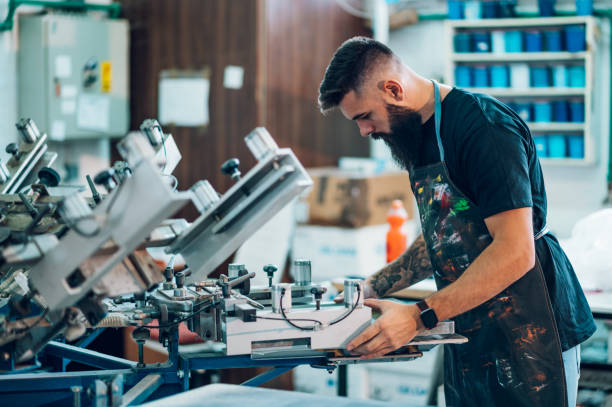Which is the best choice for screen printing vs heat transfer? Both are the methods to print on shirts and bags. However, choosing the best one for your design can be challenging. So, you must consider the cost, durability, and design versatility to select the most effective method. Heat transfer and screen printing both have their pros and cons. Yet, you can choose the best printing method that meets your needs. Hence, this blog is not an HTV vs. screen printing, but we will tell you everything you need before choosing the best method for your dream design.
What is Screen Printing?
Pros of Screen Printing
- One of the benefits of screen printing is its durability.
- Screen printing becomes more economical with larger orders. Once the screens are set up, printing in bulk is efficient and cost-effective.
- The colors in screen printing are vibrant, making your designs clear on the fabric.
Cons of Screen Printing
- Each color requires a separate screen, so designs with many colors can become complex and costly.
- The initial setting for screen printing can be time-consuming and requires a significant investment in materials and equipment.
- Due to the setup time and costs, screen printing is less economical for small orders or one-off items.
What is Heat Transfer Printing?
Heat transfer printing is a printing style that involves paper and heat to create a print on fabric. Then, a heat press pre-transfers the ink from paper to fabric. Yet, this technique is very effective for small printing and is the easiest way to get smooth and compelling prints.
Heat transfer printing has two types: Vinyl and Digital Heat Transfer.
In Vinyl Heat Transfer, we use colored vinyl that is cut into shapes or letters and heat-pressed onto the material to create a design. Hence, it's great for simple designs with solid colors.
Digital Heat Printing involves printing your design onto transfer paper using a heat press. Then, you heat press it onto the fabric. It’s ideal for complex, multi-colored designs.
You need a heat press machine, transfer paper, vinyl cutter, and printer for heat transfer printing.
Pros of Heat Transfer
- Heat transfer is perfect for short runs or individual items, as minimal setup is involved.
- You can easily create complex, multi-colored designs with digital heat transfer.
- The process is quick and straightforward, making it great for on-demand printing.
Cons of Heat Transfer
- Heat transfers tend to be less durable, potentially fading and cracking over time.
- If not applied correctly, the design may peel or crack after washing.
- While great for small orders, heat transfer can be more expensive per item when dealing with larger quantities.
Key Differences Between Screen Printing and Heat Transfer?
While comparing screen printing vs heat transfer printing, you should analyze factors that can directly affect your designs. The key differences between the both are below:
Comparison of Durability
Cost Analysis
Cost analysis is one of the most critical factors to consider. Screen printing has a higher starting set-up cost, which is expensive for smaller orders. However, once you have completed the setup, it will be cost-effective for large orders.
Heat transfer printing has deficient starting cost ratings. So, it is effective for smaller orders. However, it is more expensive than screen printing for bulk orders.
Quality of Prints
Screen printing and heat transfer both produce high-quality prints, but they offer different aesthetics. Screen printing provides vibrant colors, which is perfect for bold and simple designs. The ink used is thick, which can create a slightly raised texture on the fabric.
Heat transfer is more effective at creating complex designs and realistic images, which are difficult to achieve with screen printing. The print is smooth, although it can sometimes feel slightly stiff compared to screen printing.
Suitability
Screen printing is best for designs with few colors and simple graphics. It's versatile and used on various materials, including cotton, polyester, and blends.
Heat transfer excels with intricate, multi-colored designs. It is also effective for a wide range of materials. However, it is trendy for custom t-shirts, sports jerseys, and promotional items.
Conclusion
Screen printing vs heat transfer printing is the best choice. You may often ask this question. Both of these printing methods are effective for creating high-quality designs. Each has benefits and drawbacks. Where screen printing is best for quality and bulk orders, heat transfer printing is cost-effective and creates complex designs. So, you should analyze its durability, quality, and cost before choosing the printing method for you. By making the correct decision, you can create a design for whom you dream!
Merchcraft: The Choice of Today’s Brands
Frequently Asked Questions
How does a Vinyl Heat Transfer work?
Vinyl heat transfer works by cutting your design from vinyl and applying it to the fabrics. Then, using a hee fabric. The heat and pressure cause the vinyl to stick firmly to the material. It's a quick method, perfect for custom t-shirts and small batches.
How does Digital Print Heat Transfer work?
Digital print heat transfer involves printing your design onto special transfer paper using an inkjet or laser printer. Then, a heat press transfers the design from the paper to the fabric. The heat and pressure bond the ink to the material. It's ideal for complex designs and quick customization.
How long does screen printing last?
Screen printing lasts a long time, often retaining its durability through many washes. The thick layers of ink bond well with the fabric, making screen-printed designs resistant to fading, cracking, and peeling.
How do screen printers work?
Screen printing creates a stencil or screen of your design. Ink is spread using a squeegee. It passes through the open areas to transfer the design onto the fabric below. Each color needs a separate screen, making the process ideal for bold prints on various materials.

